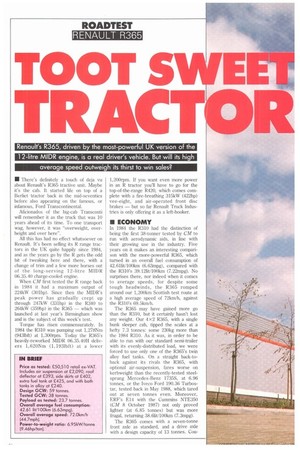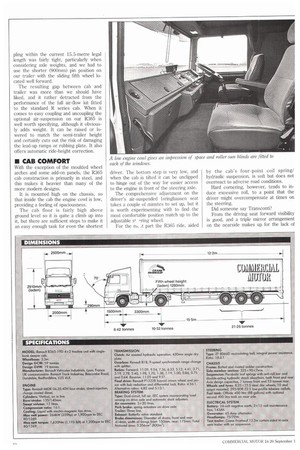TOOT SWE TRAcirolt
Page 58

Page 60

If you've noticed an error in this article please click here to report it so we can fix it.
• There's definitely a touch of deja vu about Renault's R365 tractive unit. Maybe it's the cab. It started life on top of a Berhet tractor back in the mid-seventies before also appearing on the famous, or infamous, Ford Transcontinental.
Aficionados of the big-cab Transconti will remember it as the truck that was 10 years ahead of its time. To one transport wag, however, it was "overweight, overheight and over here".
All this has had no effect whatsoever on Renault. it's been selling its R range tractors in the UK quite happily since 1984, and as the years go by the R gets the odd hit of tweaking here and there, with a change of trim and a few more horses out of the long-serving 12-litre MIDR 06.35.40 charge-cooled engine.
When CM first tested the R range back in 1984 it had a maximum output of 224kW (301hp). Since then the MIDR's peak power has gradually crept up through 247kW (331hp) in the R340 to 264kW (359hp) in the R365 — which was launched at last year's Birmingham show and is the subject of this week's test.
Torque has risen commensurately. In 1984 the R310 was pumping out 1,278Nm (9431bft) at 1,300rpm. Today the R365's heavily-reworked MIDR 06.35.401-1 delivers 1,620Nm (1,19311a1t) at a lower
1,200rpm. If you want even more power in an R tractor you'll have to go for the top-of-the-range R420, which comes complete with a fire-breathing 315kW (422hp) vee-eight, and air-operated front disc brakes — but so far Renault Truck industries is only offering it as a left-hooker.
• ECONOMY
In 1984 the R310 had the distinction of being the first 38-tonner tested by CM to run with aerodynamic aids, in line with their growing use in the industry. Five years on it makes an interesting comparison with the more-powerful R365, which turned in an overall fuel consumption of 42.61lit/100km (6.63mpg), compared with the R310's 39.121it/100km (7.22mpg). No surprises there, nor indeed when it comes to average speeds, for despite some tough headwinds, the R365 romped around our 1,200km Scottish test route at a high average speed of 72kmili, against the R310's 69.5km/h.
The R365 may have gained more go than the R310, but it certainly hasn't lost any weight. Our 4x2 R365, with a single bunk sleeper cab, tipped the scales at a hefty 7.3 tonnes: some 230kg more than the 1984 R310. As it was, in order to be able to run with our standard semi-trailer with its evenly-distributed load, we were forced to use only one of the R365's twin alloy fuel tanks. On a straight back-toback against its rivals the R365, with optional air-suspension, fares worse on kerbweight than the recently-tested steelsprung Mercedes-Benz 1735S, at 6.96 tonnes, or the Iveco Ford 190.36 Turbostar, tested back in May 1988, which tared out at seven tonnes even. Moreover, ERF's E14 with the Cummins NTE350 (CM 8 October 1987) not only proved lighter (at 6.85 tonnes) but was more frugal, returning 38.61k/1001mi (7.3mpg).
The R365 comes with a seven-tonne front axle as standard, and a drive axle with a design capacity of 13 tonnes. Con piing within the current 15.5-metre legal length was fairly tight, particularly when considering axle weights, and we had to use the shorter (900mm) pin position on our trailer with the sliding fifth wheel located well forward.
The resulting gap between cab and trailer was more than we should have liked, and it rather detracted from the performance of the full air-flow kit fitted to the standard R series cab. When it comes to easy coupling and uncoupling the optional air-suspension on our R365 is well worth specifying, although it obviously adds weight. It can be raised or lowered to match the semi-trailer height and certainly cuts out the risk of damaging the lead-up ramps or rubbing plate. It also offers automatic ride-height correction.
• CAB COMFORT
With the exception of the moulded wheel arches and some add-on panels, the R365 cab construction is primarily in steel, and this makes it heavier than many of the more modern designs.
It is mounted high on the chassis, so that inside the cab the engine cowl is low, providing a feeling of spaciousness.
The cab floor is fairly high above ground level so it is quite a climb up into it, but there are sufficient steps to make it an easy enough task for even the shortest driver. The bottom step is very low, and when the cab is tilted it can be unclipped to hinge out of the way for easier access to the engine in front of the steering axle.
The comprehensive adjustment on the driver's air-suspended Isringhausen seat takes a couple of minutes to set up, but it is worth experimenting with to find the most comfortable position match up to the adjustable st ring wheel.
For the m, ,t part the R365 ride, aided by the cab's four-point coil spring/ hydraulic suspension, is soft but does not overreact to adverse road conditions.
Hard cornering, however, tends to induce excessive roll, to a point that the driver might overcompensate at times on the steering.
Did someone say Transconti?
From the driving seat forward visibility is good, and a triple mirror arrangement on the nearside makes up for the lack of






















































































































































